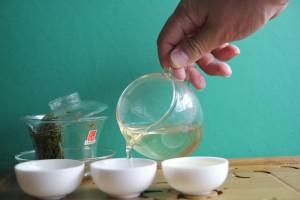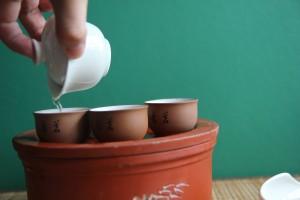This is one of those phrases that sound better in Chinese- 饮茶与品茶之别, a phrase that has a more rhythmic feel to it. Nevertheless, the intent is the same.
Or to amplify the difference, albeit with a touch of hyperbole- how do you know you are savoring a gastronomic delight instead of guzzling a water replacement?
Etymology
The word for “appreciate” – 品 (pin) – is a beautiful and apt one.
It is made up of 3 characters of 口 (kou) or mouth. It was derived from “mouths of many people” or (众多人口) where 3 is a common character in Chinese to denote many. For instance, 众 (zhong) which means multitudes or many is made up of 3 characters of 人 (ren) or human.

Amongst the uses for this word included “众口评议、评定” or the assessment or critique of many mouths- which can be translated as popular opinion.
So if we understand品, it has the connotation of assessment or critique, a differentiation of quality.
That, in my opinion, is as appropriate a word as any to denote tea appreciation.
“Drinking” on the other hand is more straightforward, consumption of liquid. It can be to satisfy thirst, it can be to meet a desire for certain tastes.
Take for example soda. When you drink soda, many of us have our preferences. Some may like the taste of Coca-Cola, others Pepsi, or 7-Up or Mountain Dew and so forth.
We enjoy the taste but it is hard to debate the merits of Mountain Dew versus 7-Up for example, because it is a matter of personal preference.
Differentiation of quality is another issue altogether.
Differentiation of Quality
When we 品茶 (pin cha), there are 3 main areas:
i) Quality of tea
ii) Appropriateness of Brewing Techniques
iii) Condition of Tea Leaves
i) is a larger topic which we will look at last.
Appropriateness of Brewing Techniques

- Parameters- quantity, water temperature & infusion time
- Brewing vessel
- Pouring techniques
- Water quality
- Steps
- How the water is boiled
- Others
Inasmuch as it is a critique of the tea, it is also an evaluation of the brewing technique, particularly if you are the brewer.
If the tea was too ‘weak’, would you have added more tea leaves, used hot water, infused longer, used another vessel, poured from a higher velocity and so forth.
Condition of Tea Leaves
This phrase is rather ambiguous- a price of brevity. What it means is how it was stored.
Some teas benefit from aging- notably dark tea and highly roasted oolongs. Hence if my Sheng Puer still feels somewhat bitter and astringent, it probably means it needs further aging.
On the other hand, if my green tea tastes sour or lacks briskness, it probably means it is not properly stored. Nothing can be remedied then- unless it was newly bought and the store has a return policy. In any case, there is a learning lesson- either in storage or vendor selection.
Connoisseurs can also enjoy observing the changes of their tea over time. For instance I know of people who buy high fired oolong by the kilograms and break up into smaller bags to open at somewhat regular intervals- i.e. 5 years, 10 years and so forth.
However it bears mentioning that not all teas aged well and this is for more experienced tea drinkers.
Quality of Tea
We have written at length about the evaluation of the quality of tea- and still adding to it.
Of particular note are the perils of focusing too much on taste alone as you can read about here and here.
Having drunk tea with people in the trade and casual tea drinkers, my observation is the latter tend to focus primarily on taste- importing much from the wine world.
My argument is that, unless you are familiar with the production- such as unique fruity nuances of Dongting Biluochun or the beany fragrance of Xihu Longjing versus Zhejiang Longjing- identification of flavor notes does absolutely nothing in evaluation of quality.
For instance, my favorite dish is Black Pepper Crab but I would retch if my tea tastes peppery or crab-like.
How it comes together is more important.
See more articles on Tea Appreciation here
